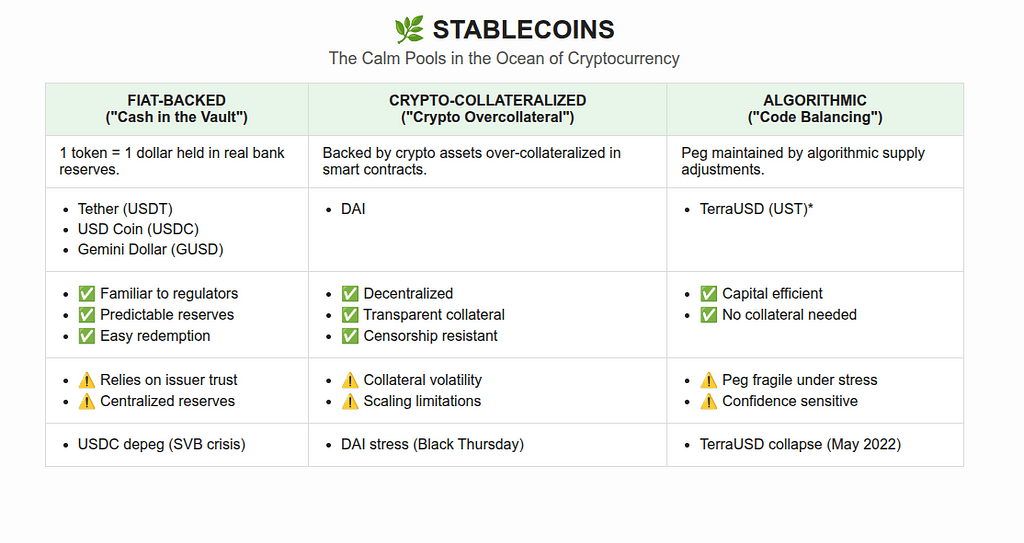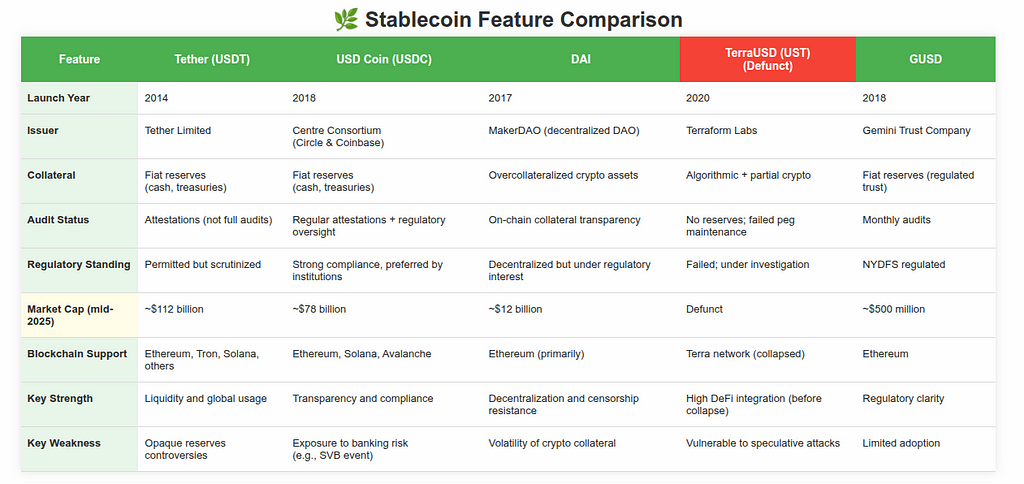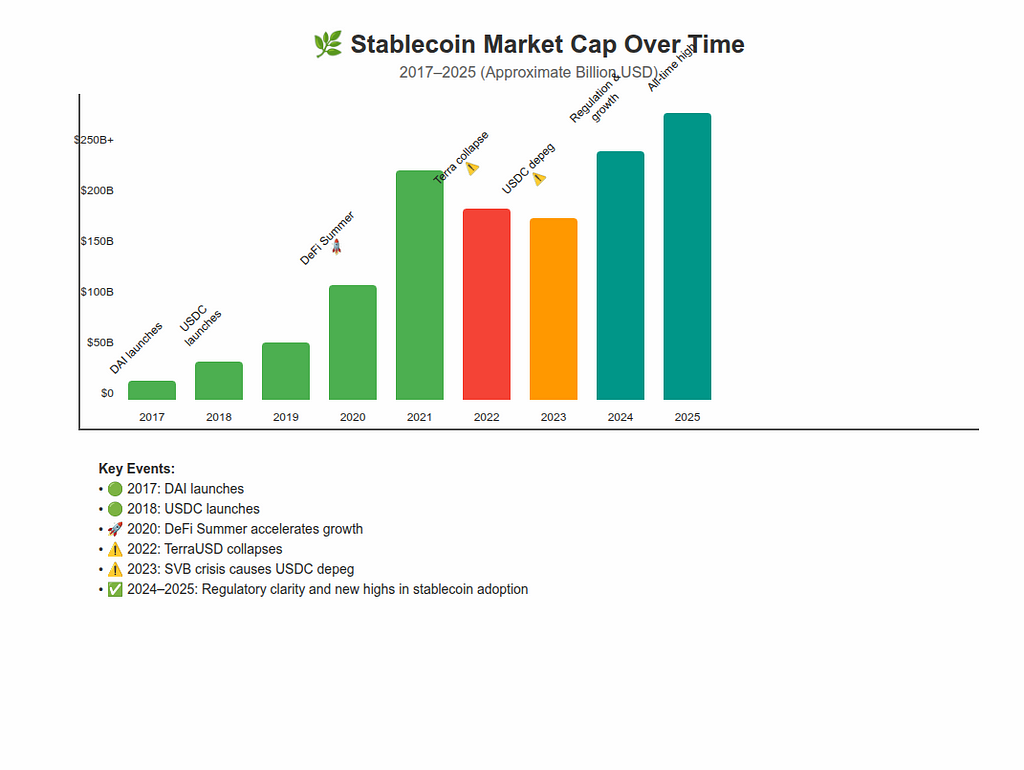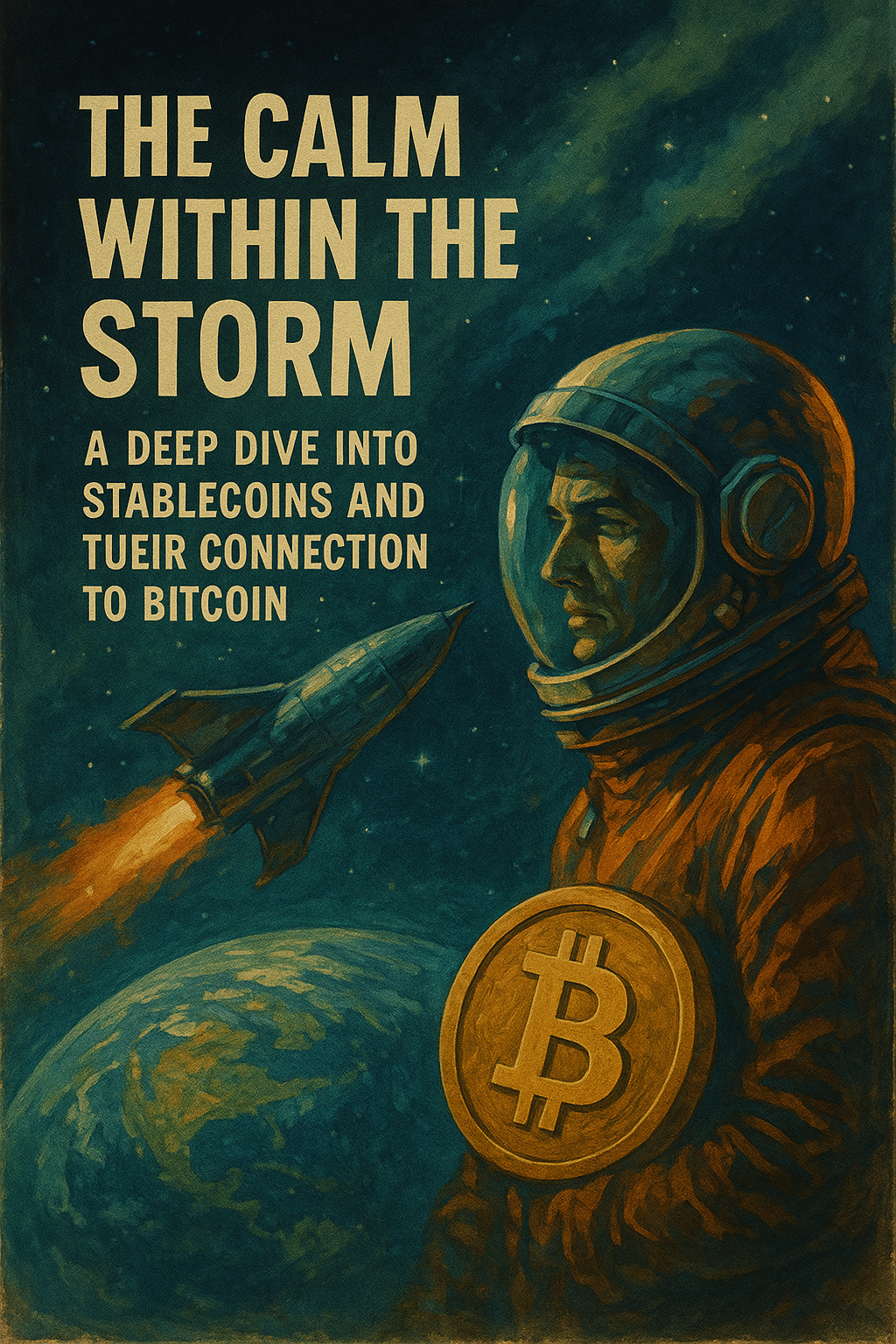🌿 A Calm Within the Storm — The Hidden Story of Stablecoins and Their Relationship with Bitcoin
Introduction:
Imagine stepping onto the deck of a ship sailing across a vast, unpredictable ocean. Some days, the sea is serene, the horizon endless, the winds gentle. Other days, towering waves crash over the rails, the sky darkens, and the ship lurches in ways that make your stomach churn.
This is how many people feel when they first encounter Bitcoin: exhilarated by possibility, unsettled by volatility.
But beneath those towering waves, something quieter has been taking shape — a new kind of financial vessel, designed not for adventure but for steadiness. These are stablecoins: digital currencies created to hold their value steady, to act as a bridge between the old world of dollars and the new world of blockchains.
This is their story: how they were born, how they rose to prominence, how they sometimes failed spectacularly, and why they remain essential to understanding the future of money.
In this exploration, you’ll find clear examples, memorable metaphors, and true stories that illuminate the delicate balance between innovation and stability.
1. Where It All Began: The Need for Something Stable
Let’s start in the earliest days — before anyone had ever uttered the word “stablecoin.”
The Early Years (2009–2013):
When Bitcoin emerged in 2009, it was a thrilling idea: money that required no bank, no government, no trust in any single institution. It was also an idea that came with an unsettling side effect: prices that could swing wildly in a matter of hours.
If you were holding Bitcoin in 2011, you might have watched it soar from $1 to $31…and then collapse back to $2. The volatility was both a promise and a warning.
At the time, no one was thinking much about ways to tame these swings. If you wanted to convert your holdings into something stable, you had only one option: cashing out to your bank account. This meant enduring delays, fees, and all the familiar red tape of traditional finance.
For early traders, it felt like being forced to row back to shore after every voyage. Each time you exited Bitcoin for dollars, you left the ocean behind.
The First Glimpse of a Solution (2014–2015):
As Bitcoin gained popularity, it became obvious that the crypto world needed a safe harbor — something that could combine blockchain’s instant settlement with the familiar stability of a dollar.
In 2014, a small project called Realcoin quietly rebranded itself as Tether.
Tether’s idea was simple, almost elegant in its obviousness:
- For every digital token issued, there would be $1 held in reserve somewhere safe.
- These tokens could be moved and traded on blockchains just like Bitcoin.
- They would always (in theory) be worth exactly one dollar.
This concept turned out to be more revolutionary than it seemed.
A Key Insight:
Tether’s arrival showed that while people loved the adventure of Bitcoin, they also wanted a lifeboat: a digital dollar that could float calmly alongside the stormy seas of speculation.
For the first time, traders no longer had to row back to shore every time the waves got rough. They could stay in the ecosystem — settling trades, holding funds, and exploring DeFi — without leaving the water.
2. How Stablecoins Work: Three Approaches to Taming Volatility
Let’s open the hood and examine the mechanics that make a stablecoin tick.

Although dozens of stablecoins exist, nearly all of them fit into one of three main categories. You can think of them as three different kinds of ships:
1) Fiat-Backed Stablecoins: The Steel-Hulled Tanker
These are the most straightforward.
How they work:
- For every token issued, there’s supposed to be $1 (or equivalent safe assets) sitting in a real-world bank account.
- Whenever you wish, you can redeem your token for actual dollars.
- This reserve is what keeps the token’s price anchored.
Examples:
- Tether (USDT): Launched in 2014, still the most widely traded stablecoin.
- USD Coin (USDC): Launched in 2018 by Circle and Coinbase, designed to be more transparent and regulated.
- Gemini Dollar (GUSD): Issued by a New York trust company, known for regulatory clarity.
Strengths:
- Familiar to regulators and institutions.
- Easy for newcomers to understand.
Weaknesses:
- Requires trust that the issuer actually holds the reserves.
- Sometimes opaque about exactly what assets back the tokens.
2) Crypto-Collateralized Stablecoins: The Overbuilt Sailboat
This category relies on crypto as collateral.
How they work:
- Instead of holding dollars, the system locks up crypto assets — like Ethereum — in smart contracts.
- Because crypto is volatile, users must deposit more collateral than the stablecoins they receive (often 150% or more).
- If the collateral value falls too much, the system automatically sells it to maintain stability.
Example:
- DAI: Created by MakerDAO, DAI is the most successful decentralized stablecoin.
Strengths:
- Decentralized — no single issuer can freeze or censor accounts.
- Transparent — anyone can verify the collateral.
Weaknesses:
- Scaling is hard because overcollateralization requires a lot of locked-up capital.
- During rapid market crashes, collateral can be liquidated in a frenzy.
A Story to Remember:
In March 2020, when COVID panic hit global markets, Ethereum’s price crashed 50% in a day. The congestion in the network delayed automatic liquidations. DAI briefly fell below $1. MakerDAO had to auction off special governance tokens to stabilize the system.
3) Algorithmic Stablecoins: The Delicate Balancing Act
These are the most experimental — and, so far, the most prone to dramatic failure.
How they work:
- No reserves in dollars or crypto.
- Instead, algorithms expand and contract supply to keep the price around $1.
- If the price falls, the system buys tokens or offers incentives to reduce supply.
- If the price rises, it mints more tokens to bring it back down.
Example:
- TerraUSD (UST): At its peak in 2022, UST had over $18 billion in circulation.
The Collapse:
In May 2022, confidence in TerraUSD evaporated almost overnight:
- A wave of withdrawals triggered a self-reinforcing crash.
- The algorithm could no longer keep up.
- UST fell to mere cents, wiping out over $40 billion in value.
The Terra collapse became a cautionary tale — a reminder that even brilliant code can’t always substitute for robust collateral.

3. When Stability Shapes Destiny: How Stablecoins Influence Bitcoin’s Price
It might seem odd that something designed to be boring — a dollar that stays a dollar — would have such a profound effect on Bitcoin, the original rollercoaster asset. Yet again and again, history has shown that stablecoins are not mere bystanders. They are the bloodstream that keeps the whole organism alive.
Let’s walk through a few pivotal moments when stablecoins shaped Bitcoin’s story.
2017: The First Big Wave
As Tether’s supply began to grow rapidly, it became a vital trading pair for Bitcoin.
- Tether let traders move large sums quickly between exchanges.
- It allowed people to exit volatile positions without going back to banks.
- Many analysts believe Tether’s expansion fueled Bitcoin’s dramatic rise to nearly $20,000 that December.
2020–2021: The Era of Institutional Adoption
When large investors began entering crypto, they needed settlement tools they could trust.
- USDC, with its audits and regulatory pedigree, became a preferred vehicle for institutions.
- By 2021, Tether’s market cap passed $50 billion.
- Bitcoin reached all-time highs of nearly $69,000.
2022: The Terra Crisis
As TerraUSD unraveled, panic spread.
- Billions of dollars fled UST into USDC and USDT.
- Bitcoin fell below $20,000 as traders sold to cover losses.
2023: The Banking Scare
When Silicon Valley Bank collapsed, Circle revealed $3.3 billion of USDC reserves were stuck.
- USDC temporarily traded at $0.88.
- Traders rushed into Tether.
- Bitcoin dipped, then rebounded as confidence returned.
2025: A Maturing Market
Today, stablecoins exceed $250 billion in circulation.
- They remain the lubricant that keeps trading smooth.
- Without them, Bitcoin’s price would be more volatile and liquidity more fragile.

4. The Risks That Lurk Beneath the Surface
Stablecoins often feel so reliable that it’s easy to forget the risks that hide behind the calm facade.
Counterparty Risk:
- Fiat-backed stablecoins depend on issuers to actually hold reserves.
- Tether has faced years of skepticism.
- USDC’s depeg during the SVB crisis showed even audited reserves can be vulnerable.
Regulatory Risk:
- Governments have realized stablecoins can threaten monetary policy.
- The EU’s MiCA framework in 2024 imposed strict caps and reporting requirements.
- In 2025, the US passed the GENIUS Act, requiring federal licensing and monthly attestations.
Collateral Risk:
- Crypto-backed stablecoins can fail if collateral value crashes.
- Algorithmic stablecoins can enter death spirals if confidence falters.
Each of these risks has reshaped market behavior and forced builders to innovate — sometimes painfully.
5. The World Outside: How Macroeconomics Shape Stablecoin Use
Stablecoins do not exist in a vacuum. Their adoption and survival are profoundly shaped by the larger economic currents that swirl far beyond the world of blockchains.
Let’s explore three of the most important forces:
Interest Rates:
When central banks raise interest rates, holding cash becomes more attractive.
Imagine you’re an investor in 2022–2023, when the Federal Reserve pushed rates toward 5%:
- Suddenly, parking money in a Treasury bill yields safe returns.
- Sitting in a stablecoin, by comparison, feels less appealing.
This led some capital to move out of stablecoins and into traditional yield-bearing instruments. The effect?
- Liquidity on crypto exchanges thinned a little.
- Bitcoin inflows slowed.
Just like weather systems can steer ocean currents, central bank policy can subtly redirect the flow of money through stablecoins.
Inflation:
In other parts of the world, the opposite dynamic played out.
Consider Argentina, where inflation has repeatedly surged beyond 50%. Or Turkey, where the lira lost half its value in a single year.
For citizens there, stablecoins are more than trading tools: they are lifelines.
- Families use USDT or USDC to store value.
- Merchants accept stablecoins to avoid local currency devaluation.
- Small investors learn about Bitcoin after first dipping their toes in stablecoins.
In these economies, inflation became an unexpected marketing campaign for the digital dollar.
Financial Crises:
During times of global turmoil, stablecoins have become digital safe havens.
In March 2020, when COVID-19 froze economies worldwide:
- The stock market crashed.
- Treasury yields evaporated.
- Crypto prices halved in days.
Yet stablecoin issuance spiked:
- Traders and funds moved into Tether and USDC rather than exiting the crypto ecosystem entirely.
- This preserved liquidity that later helped fuel Bitcoin’s recovery.
These examples show a paradox: the more unstable the world becomes, the more people seek something stable — even if that “something” lives on a blockchain.
6. The Road Ahead: Regulation, Innovation, and a New Era of Finance
If you’ve followed this story so far, you may already sense what comes next: stablecoins are no longer a side show. They are a central pillar of the new financial architecture.
Let’s look at how this pillar is evolving.
Mainstream Adoption:
By 2025, major companies began integrating stablecoins into their payment flows.
- PayPal announced a stablecoin-based remittance service.
- Visa piloted settlements using USDC.
These moves reflect a simple truth: for many users, stablecoins are easier to understand than Bitcoin. A dollar is a dollar, no matter where it lives.
Regulatory Maturity:
Early stablecoins thrived in a regulatory vacuum. Those days are over.
- In 2024, Europe’s MiCA framework imposed consumer protection rules and caps on daily payment volumes.
- The US followed in 2025 with the GENIUS Act:
- Every stablecoin issuer must be federally licensed.
- Monthly reserve attestations are required.
- Redemption rights are codified into law.
This legal scaffolding is both a constraint and a blessing: it makes life harder for dubious operators, but it provides clarity for institutions.
CBDCs (Central Bank Digital Currencies):
Around the world, central banks are racing to launch their own official digital money.
- China’s e-CNY has been piloted in dozens of cities.
- Europe is accelerating its digital euro.
- The US is exploring how FedNow might integrate with CBDCs.
How will these coexist with stablecoins?
- CBDCs will likely be used for domestic transactions, government disbursements, and social benefits.
- Stablecoins will remain programmable, borderless, and more flexible.
Rather than replacing each other, they will create a rich tapestry of digital currencies — some state-controlled, some market-driven.
DeFi Integration:
Decentralized finance is evolving beyond the first experiments in lending and trading.
- MakerDAO is adding real-world assets like Treasury bills as collateral.
- Aave launched GHO, a decentralized stablecoin.
- Uniswap integrated stablecoin pools to improve liquidity.
In this expanding ecosystem, stablecoins have become the connective tissue — the means of exchange, the collateral, and the settlement layer.
A Prediction:
Stablecoins will continue to blur the boundaries between traditional finance and crypto.
- They will power cross-border payments.
- They will enable merchants to accept digital dollars without worrying about volatility.
- They will help Bitcoin remain liquid, accessible, and integrated into the global financial system.
7. Reflections: The Quiet Revolution in Plain Sight
If you step back and look at the arc of this story, you’ll see something remarkable.
Stablecoins began as a humble tool — an attempt to solve the mundane problem of how to hold dollars without leaving the blockchain. Over a decade, they became:
- The main currency pair for Bitcoin trading.
- A hedge against inflation in emerging economies.
- The backbone of DeFi.
- A proving ground for regulation.
- A catalyst for central banks to modernize their own currencies.
And yet, they have remained true to their mission: stability.
In a space full of dazzling hype and overnight millionaires, stablecoins have offered something different: reassurance. They remind us that not every innovation has to feel like a gamble.
They are the bridges. The ballast. The calm pools in a churning sea.
Conclusion: A Gentle Invitation to the Curious
Perhaps you began this journey with only a passing knowledge of Bitcoin, unsure why anyone would need a “stablecoin.” By now, you have seen that these tokens are much more than a convenience.
They are:
- The infrastructure that makes trading possible.
- The tool that helps people survive inflation.
- The conduit that moves billions across borders instantly.
- The hidden foundation supporting Bitcoin’s rise.
And as our financial systems continue to evolve, stablecoins will remain at the heart of the story — sometimes controversial, sometimes imperfect, but always essential.
If you are curious about crypto, start here. Learn how stability is built, maintained, and sometimes lost. Discover how trust is woven into code and collateral. And consider what it means to create something that stays steady while everything around it moves.
Because in the stormy sea of digital money, it is the calm pools that help us see the horizon more clearly.
🌿 A Calm Within the Storm — The Hidden Story of Stablecoins and Their Relationship with Bitcoin was originally published in The Capital on Medium, where people are continuing the conversation by highlighting and responding to this story.
